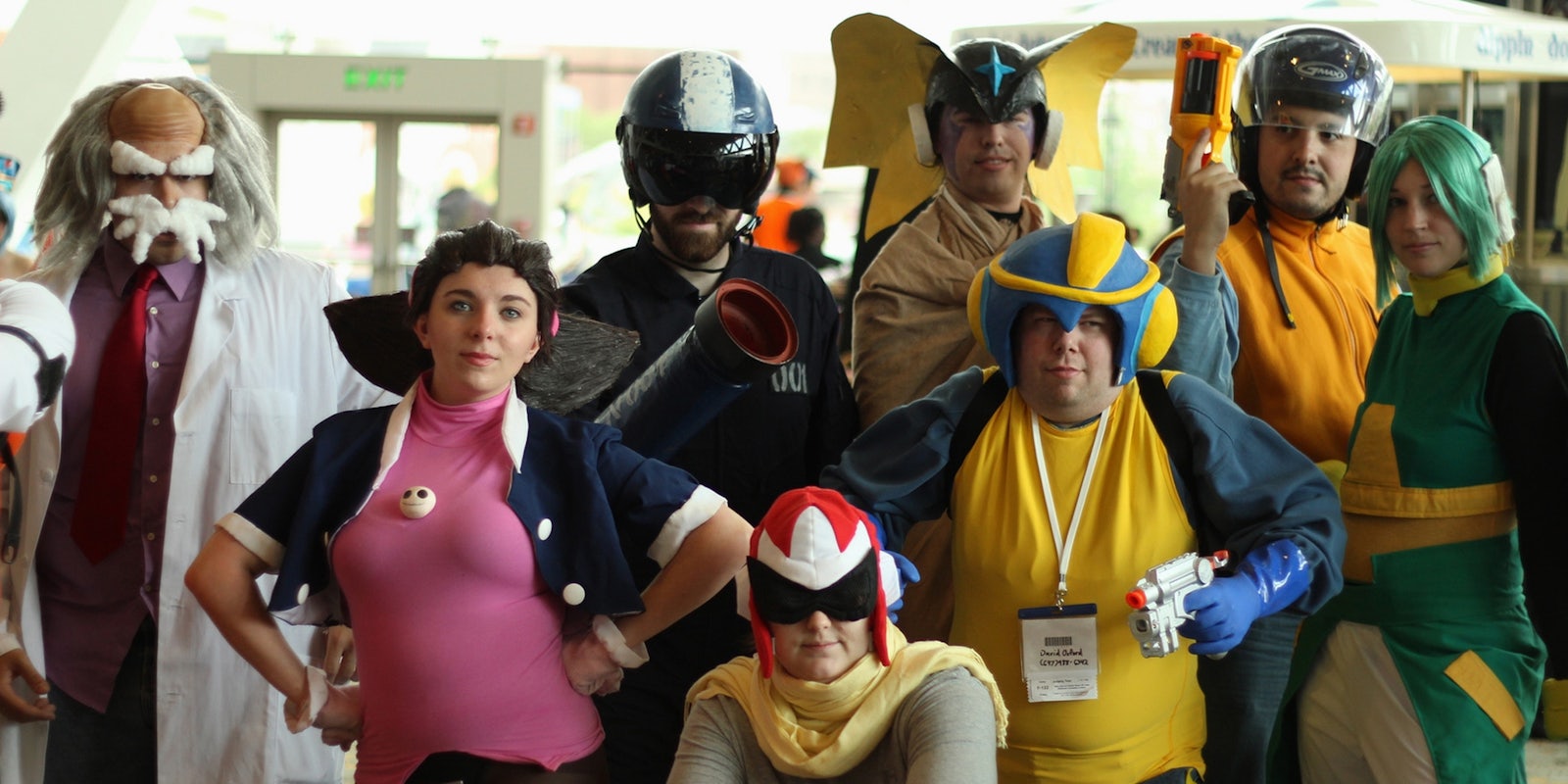By CHARLES DUNBAR
The weekend before last, I attended my fifth Anime USA in Washington, DC. It was my 14th anime convention this year, and 70th overall. By now, walking down halls full of cosplayers and clusters of attendees sharing Nintendo Streetpass tags has become a major part of my life. Despite all the time I’ve spent “in the field” (as I still think of a lot of my con-going adventures), each con holds a special place to me, a reflection of a community I’ve watched grow and evolve over the past 11 years.
When I attended my first anime convention back in 2002, I felt like I was entering another world.
By that year, I had already been a “veteran” attendee of the Long Island SF/Fantasy event ICON, held annually at SUNY Stonybrook. I first attended ICON due to my being one of the few “geeks” in my high school—there were only two others who played Magic: The Gathering, read fantasy novels and could quote Star Wars verbatim—and I was looking for others who shared my love of gaming, reading, and anime (though the latter was still in its infancy in my fandom life). I was a boy seeking a community to belong to, and ultimately ICON was the only event I knew of.
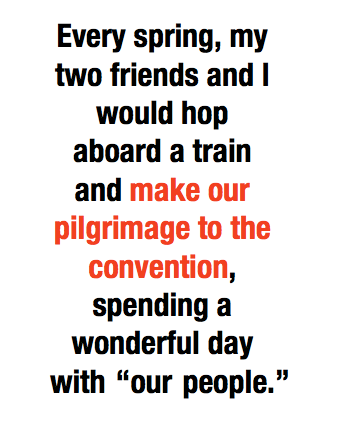 But for a geeky teenager in Queens at the time, ICON was the event, organized by passionate fans and with a long pedigree in the geek community. It drew artists, writers, game designers and all sorts of media stars, promising a large, communal space where people with “offbeat interests” could gather and interact with one another. So every spring, my two friends and I would hop aboard a train and make our pilgrimage to the convention, spending a wonderful day with “our people.”
But for a geeky teenager in Queens at the time, ICON was the event, organized by passionate fans and with a long pedigree in the geek community. It drew artists, writers, game designers and all sorts of media stars, promising a large, communal space where people with “offbeat interests” could gather and interact with one another. So every spring, my two friends and I would hop aboard a train and make our pilgrimage to the convention, spending a wonderful day with “our people.”
The irony of this pilgrimage, however, was that for all the years we attended the con we never actually made any friends, nor participated in any community events outside of attending the con itself. Either we were too young for one group, not “hardcore” enough for another, or too “green” and asked to “come back in a few years.” As fans whose previous contact with fandom was only each other, this was both sobering and a little disappointing, as all we wanted to do was belong. Even at the convention we found ourselves somewhat excluded by the other fans who attended.
***
Fast forward a few years when I walked into the Marriott Marquis Times Square for Anime Expo NY one August afternoon—and into a life-changing experience.
I was used to large halls full of vendors selling whatever goods I could possibly want, from dice and games to soundtracks and VHS tapes of my favorite anime series; pursuits like tournaments (both foam weapon and dice/card-based); film screenings; book discussions; and old-timers from generations past ranting about how everything was better back in their day. These were very loose but independent communities centered around what their participants enjoyed the most or which circles would accept them. AXNY was none of those things. Aside from it not being the sci-fi/fantasy convention culture I was used to, it was also a gigantic, living entity structured around art, merchandise, costumes, and—above all—community. I made friends in my first moments on the floor, and found myself pulled toward event after event as though rushing down a river: video screenings, panels, karaoke, shopping. To be honest, today I can’t remember the details of any of those events. The emotion and the acceptance, however, remains. It was beyond anything I had ever experienced before.
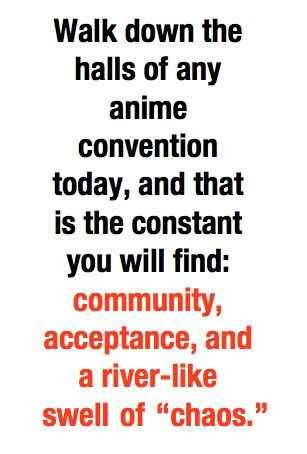 Walk down the halls of any anime convention today, and that is the constant you will find: community, acceptance, and a river-like swell of “chaos.” The chaos I refer to here is akin to a parade, rock concert, street festival, or religious revival, and all supposedly centered around the pursuit and appreciation of Japanese animation and culture. The key word being “supposedly”—take a look closer at the event, and you will find that the pursuit of Japanophilia is often secondary. The “official” goals of anime conventions are eclipsed more and more by the general pursuit of being a fan and what being a fan means: finding that place for yourself within an open, accepting community.
Walk down the halls of any anime convention today, and that is the constant you will find: community, acceptance, and a river-like swell of “chaos.” The chaos I refer to here is akin to a parade, rock concert, street festival, or religious revival, and all supposedly centered around the pursuit and appreciation of Japanese animation and culture. The key word being “supposedly”—take a look closer at the event, and you will find that the pursuit of Japanophilia is often secondary. The “official” goals of anime conventions are eclipsed more and more by the general pursuit of being a fan and what being a fan means: finding that place for yourself within an open, accepting community.
Yes, certainly, anime culture thrives at the con. Anime cosplay is always a strong element, as is programming that caters to those who have a thirst for information and education about Japan/East Asian culture. Artists in the Alleys still sell prints of favorite characters, alongside handmade models of everything from Pokemon to Cthulhu. Vendors cater to the needs of hungry consumers with the latest figures and series (often imported straight from Japan); video screenings of the newest films by directors such as Makoto Shinkai and Mamoru Hosoda draw lines around corners and down stairways.
But anime is no longer the only culture present here, nor, frequently, even the visibly dominant one. More and more often at these conventions anime now shares the stage with popular webcomics, American series (both animated and live-action), American comics, British dramas, Korean popular music, gaming in all its forms, literature discussion, and general “geek culture” (a far cry from pure anime culture).
In fact, as I walk through the halls of conventions today both large and small, local and regional, new and old, what I find more and more frequently resembles the halls of ICON I first wandered in the late ’90s. With one major difference: Unlike some of the fellows I met at ICON over the years, the fans at the anime cons are glad to see you, and want to be your friend.
***
In 2009, I was a hungry graduate student eager to explore the convention community that I had been a part of from an anthropological perspective. I arrived with all these notions of the community I had “grown up” in, based around the people I had met at AXNY, several AnimeNexts, and one Big Apple Anime Fest in the early ‘00s. I had assumed that the convention community I was about to encounter for my studies would be more or less the same, perhaps with some new “flavor of the month” series, but generally still full of the same welcoming otaku interested in talking about anime.
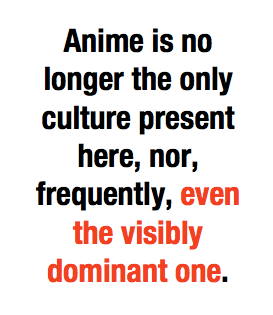 It took only a single convention, Anime Boston, to show me how wrong I was. What I discovered that year was the beginnings of an extraordinary shift in the anime convention community dynamic, a shift that would alter the structure of the events, and breathe life into a single fandom interest. The circle was coming back around, with anime now occupying the same spaces the general SF/Fantasy conventions had decades ago: providing a home to all things “geeky” and giving fans a place to go to experience it all.
It took only a single convention, Anime Boston, to show me how wrong I was. What I discovered that year was the beginnings of an extraordinary shift in the anime convention community dynamic, a shift that would alter the structure of the events, and breathe life into a single fandom interest. The circle was coming back around, with anime now occupying the same spaces the general SF/Fantasy conventions had decades ago: providing a home to all things “geeky” and giving fans a place to go to experience it all.
Those fans, a new generation from the one I had grown up in, were now placing value and importance on something new and different—community, above all else, above even the “rules” and practices of previous generations. Their interest in anime was still there, but rather than defining themselves as anime fans, they were now fans of anime, and often alongside other things. What they valued was not knowledge about anime, or maintaining deep “databases” (as Hiroki Azuma might describe it) of information relating to anime, but rather the creation and perpetuation of a community of which anime was but one facet.
Community had replaced the medium as the motivation for attendance. Meeting people had become more important than knowing things.
I shouldn’t have been surprised, honestly. Nobody really should be. While anime conventions were started to promote Japanese animation in the United States, the fandom that attends and sustains these conventions is subject to the same ebb and flow of any cultural expression. It evolves. Older fans are replaced by younger ones who have a different idea of both what fandom is, and how to practice it. Some of these younger fans might have come to the fandom on their own, completely unassisted by “veteran fans.” The Internet evolves, and the expression of fandom changes from debate and discovery to expression and creativity (not that creative expression wasn’t a big part of that same community in the first place). “Wayward fans” of non-Asian media walk through the doors to find others who appreciate their fandom just as much as they appreciate anime. Friendships are formed, communities develop among these groups of friends, and the convention changes.
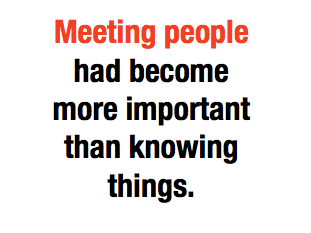 It’s a basic fact of life. Culture evolves and thrives, or stagnates and dies off. Fandom culture is no different. For fandom in the 21st century, the process is greatly accelerated, with television, film and the Internet saturating themselves with content both official and fan-crafted. That new content in turn brings in new fans and new fandom experiences, fans who then bring their newfound fandom (and their new dynamic) to the conventions and spread it among their peers and curious onlookers. And that healthy curiosity for new and exciting things—often the method by which fans came to anime in the first place—allows the fans and attendees to absorb the new content in the same ways, further altering how the individual fan chooses to identify themselves as both a fan and consumer of media.
It’s a basic fact of life. Culture evolves and thrives, or stagnates and dies off. Fandom culture is no different. For fandom in the 21st century, the process is greatly accelerated, with television, film and the Internet saturating themselves with content both official and fan-crafted. That new content in turn brings in new fans and new fandom experiences, fans who then bring their newfound fandom (and their new dynamic) to the conventions and spread it among their peers and curious onlookers. And that healthy curiosity for new and exciting things—often the method by which fans came to anime in the first place—allows the fans and attendees to absorb the new content in the same ways, further altering how the individual fan chooses to identify themselves as both a fan and consumer of media.
Now fill an entire convention with people who think, feel, and experience fandom along those lines.
There has been some talk online and at the con that anime fandom is somehow “dying.” Critics and passionate fans point to these multi-fandom pursuits, and demand that the con change to accommodate their needs, be it through restricting/adding more non-anime programming or redefining mission statements to include/exclude practices within the fandom that they find limiting or “dangerous.” They either want the con to return to its “roots”—as a place where anime culture is the sole culture represented—or for the con to remove all mention of the term “anime” from its name, to reflect the changed nature of both the attendees and the attached culture. Others call for the convention to accept that things have changed in the name of embracing a new generation of fans that have different priorities within the community. Both sides point to the attendees and say their point is valid.
This is false criticism on both accounts. Anime fandom is alive and well, and thrives among tens of thousands of fans who watch and dress like their favorite series. But many of these anime fans are also actively devoted to other pursuits, and those might be just as important to them. For many of these same fans, the conventions are fine just the way they are.
***
A few years ago, I was reading the seminal work Convergence Culture by UCLA professor Henry Jenkins, and something struck a chord. In the book, Jenkins made it a point to describe new media as centered around fans “who will go anywhere in search of the kind of entertainment experiences they want.” Eschewing the “classic” model of production-driven experience of media (whereby fans consume what the producers dish out to them, with little impact on their own), Jenkins claimed that fans will migrate to where they feel fulfilled, and experience their fandom in ways meaningful to them: fan fiction, web forums, games, and interpersonal interactions.
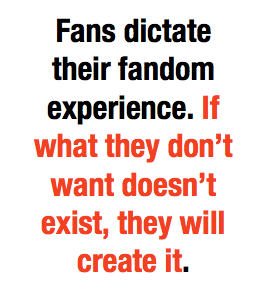 To put this more plainly: fans dictate their fandom experience. If what they want doesn’t exist, they will create it. Now take this idea, and lay it onto the contemporary convention culture. It is these fandom interactions which drive growth and community. The community begins to supplant the medium, interaction supersedes devotion to a specific fandom, and the interactions between fans are valued just as greatly as the interactions between consumer and producer. Convergence alters the relationship, logic, and method by which fandoms operate. It also alters the definitions of what qualifies as fandom practice, often heavily influenced by the personal desires and goals of the specific fan in question and how they have approached fandom itself.
To put this more plainly: fans dictate their fandom experience. If what they want doesn’t exist, they will create it. Now take this idea, and lay it onto the contemporary convention culture. It is these fandom interactions which drive growth and community. The community begins to supplant the medium, interaction supersedes devotion to a specific fandom, and the interactions between fans are valued just as greatly as the interactions between consumer and producer. Convergence alters the relationship, logic, and method by which fandoms operate. It also alters the definitions of what qualifies as fandom practice, often heavily influenced by the personal desires and goals of the specific fan in question and how they have approached fandom itself.
Fans want what they want. They are unashamed of what they want. They will do whatever they feel is necessary to achieve what they want from the fandom community. And they will pick up others like them along the way. Add the anime convention, and the following mood prevails: “All are welcome, just leave your attitude at the door. If you like anime, great! If you don’t, I’m sure we will have something in common to talk about, and maybe we can introduce each other to something new for both of us. Now let’s go have a good time at the con.”
This is the positive position so many anime conventions now find themselves in. Fans of multiple things pack the halls, exchanging energy, exuberance, and their own particular variations on the practice of being fans. Many (if not most) of these fans appreciate and enjoy anime, but that appreciation might share the “stage,” or be secondary to something else: media, or creative endeavors, or fandom in general, or even simple interaction with others. They come to the con because they are seeking a welcoming place to “test the waters,” free of judgement and willing to accept them for who they are, [fandom] flaws and all. That lack of being judged, for fear of being called a “fake geek,” is generally absent from many (if not most) of the cons I attend each year, and I always find myself crossing paths with an eager first-timer who cannot believe how open so many of the other attendees are.
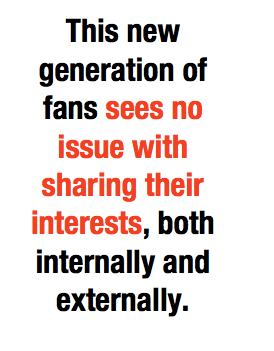 Some of these may even be part of some completely different fandom from anime, and are looking for a place to go and practice. They might have never seen a single episode of any series, but are instead devoted to Doctor Who, or Homestuck or My Little Pony, and the anime con is their only outlet- either because the “general geek” convention doesn’t exist, or is a “closed” community to new members.
Some of these may even be part of some completely different fandom from anime, and are looking for a place to go and practice. They might have never seen a single episode of any series, but are instead devoted to Doctor Who, or Homestuck or My Little Pony, and the anime con is their only outlet- either because the “general geek” convention doesn’t exist, or is a “closed” community to new members.
Regardless of whether the con “approves” of their idea of fandom or not, these fans know they will not be alone. If the anime convention chooses to accommodate then, then “awesome,” they will pack those panels and cheer as loudly as possible. If the con does not, they will organize their own photo-shoots, sell their own fan-art, and hold their own panels and screenings somewhere else. They’re glad to be there either way, because these people are “awesome,” and maybe they can change a few minds along the way.
***
Anime hasn’t lost value in the minds of these fans; rather, other fandoms have gained it. This new generation of fans sees no issue with sharing their interests, both internally and externally. They bring this pursuit with them to the con, where they meet with other fans. Their idea of being a fan, shaped by their experiences and interaction with others in the community, may be different than what other fans might be used to—but ultimately they are still centered around being a fan, practicing their fandom and seeking out others with which to practice and share their interests.
Maybe some of the non-anime fans will “discover” anime while at the con, or find their own anime fandom further enriched as a result. Maybe not.
Despite how much the idea of fandom has shifted, in the end, all that matters is that they are at the con, among their “people,” and practicing what’s important to them.
Charles Dunbar is an anthropologist, journalist, editor and fan of many things (anime being just one of them). Dunbar is the founder of StudyOfAnime.com, a senior editor for the online culture site “Real Otaku Gamer,” where he writes convention, manga and movie reviews, editorials, culture articles, anime first impressions and looks back at the games and shows of yesteryear.
Photo by Zippo S/Flickr

